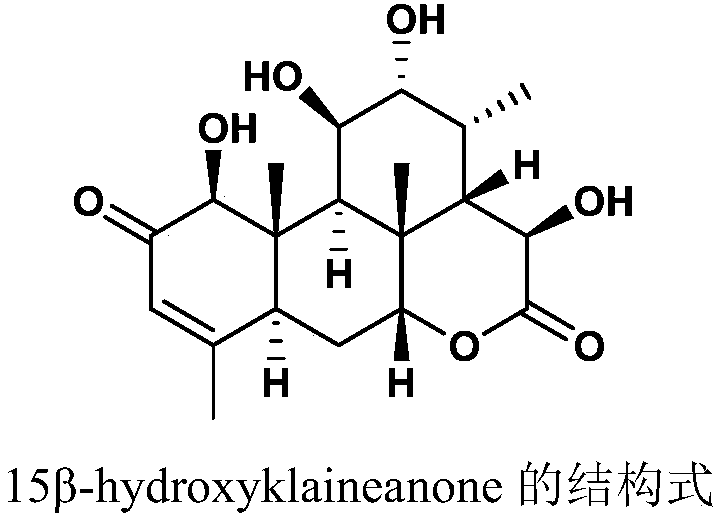Insect antifeedant 15beta-hydroxyklaineanone conducted in plants and application
A technology of antifeedant and plant body, which is applied in the directions of plant growth regulator, application, and pest repellent, can solve the problems of loss of efficacy and interference effect, and achieve the effects of environmental friendliness, high antifeedant activity, and convenient use.
- Summary
- Abstract
- Description
- Claims
- Application Information
AI Technical Summary
Problems solved by technology
Method used
Image
Examples
Embodiment 115
[0036] Example 115 The plant systemic properties of β-hydroxyklaineanone and its antifeedant activity after systemic absorption
[0037] Method: Dissolve 15β-hydroxyklaineanone with methanol, then prepare the solution to a final concentration of 100μg / mL, and spread it evenly on the surface of a 1.2 cm diameter circular cabbage leaf disc. The amount of medicine applied to each leaf disc When the methanol on the surface of the leaf disc is naturally dried, the 3rd instar larvae of Plutella xylostella (Linnaeus) are inserted. The treatments at each concentration are repeated 3 times at a relative humidity of 50% to 70% and a temperature of 25°C to 28 After keeping in an environment of ℃ for 24 hours, the feeding area was counted, and the feeding rate and refusal rate were calculated.
[0038] The antifeedant activity of 15β-hydroxyklaineanone on the first instar larvae of Spodopteralitura (Fabricius) was tested with cassava leaves; the antifeedant activity of 15β-hydroxyklaineanone o...
Embodiment 2
[0046] Example 2 15β-hydroxyklaineanone can be absorbed into the roots of Shanghai greens from the growth environment of Shanghai greens through the roots, and is transported upwards to the leaves, so that insects refuse to eat greens green leaves
[0047] Method: Dissolve 15β-hydroxyklaineanone with DMSO to prepare a mother liquor of 10000μg / mL, then use 0.5mM CaCl 2 The aqueous solution dilutes the mother liquor to a 100μg / mL culture solution. Place the pre-cultivated Shanghai green seedlings (6 leaf stage, not treated with 15β-hydroxyklaineanone) in 0.5mM CaCl 2 After pre-incubating in an aqueous solution for 2 hours, transfer it to the above-mentioned prepared 15β-hydroxyklaineanone culture solution. After 24 hours, take 0.5 g of the apical leaves of the seaweed, mash it and dissolve it in 2 mL of methanol. The liquid chromatography-mass spectrometer can be used to It was detected that the leaf extract contained 15β-hydroxyklaineanone. According to calculations, the content of...
Embodiment 3
[0049] Example 3: 15β-hydroxyklaineanone can be absorbed from the growth environment of the Chinese cabbage through the roots into the inside of the Chinese cabbage root, and transported upwards to the leaves, so that the vegetable aphid Lipaphiserysimi can resist eating the cabbage leaves
[0050] Method: Dissolve 15β-hydroxyklaineanone in methanol to prepare a mother liquor of 10000μg / mL, then use 0.5mM CaCl 2 The aqueous solution dilutes the mother liquor to a 100μg / mL culture solution. Place the previously cultivated Chinese cabbage seedlings (6 leaf stage, not treated with 15β-hydroxyklaineanone) in 0.5mM CaCl 2 Pre-incubate in aqueous solution for 2 hours and then transfer to the above prepared 15β-hydroxyklaineanone culture medium. After 24 hours, insert wingless cabbage aphids, 100 per cage, repeat 4 times, and count the control aphid 24 hours later. The number of aphids living on the leaves and the treated leaves, and the formula for calculating the antifeedant rate is as...
PUM
 Login to View More
Login to View More Abstract
Description
Claims
Application Information
 Login to View More
Login to View More - R&D
- Intellectual Property
- Life Sciences
- Materials
- Tech Scout
- Unparalleled Data Quality
- Higher Quality Content
- 60% Fewer Hallucinations
Browse by: Latest US Patents, China's latest patents, Technical Efficacy Thesaurus, Application Domain, Technology Topic, Popular Technical Reports.
© 2025 PatSnap. All rights reserved.Legal|Privacy policy|Modern Slavery Act Transparency Statement|Sitemap|About US| Contact US: help@patsnap.com



